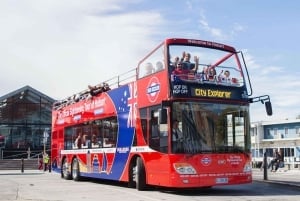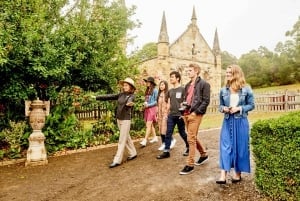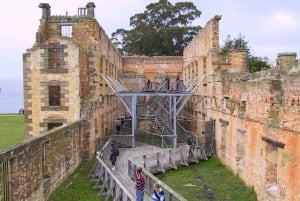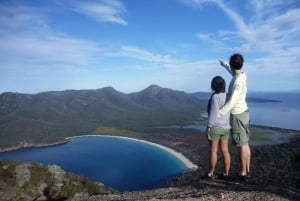History and Culture
Tasmania is in many respects unique in wildlife and geology and quite different to mainland Australia. Tasmania is a land formed through volcanic upheaval and glaciers giving it beautiful mountain ranges and alpine regions. With 1144 named mountains Tasmania is Australia’s most mountainous state. The west coast of Tasmania is world famous for its geology and mineralisation. Having been isolated for such a long time Tasmania has flora and fauna that is unique and can be traced back to the time that it was part of the Gondwana supercontinent.
First Settlers
Tasmania was first settled some 40 000 years ago via a land bridge that connected it with mainland Australia and which began flooding at the end of the last ice age about 12 000 years ago. This left Tasmanian aboriginals cut off from outside influences for the last 8000 years until the coming of European whalers, sealers and colonisers.
Population figures for native Tasmanians prior to European colonisation vary widely but may have been from 15 000 up to 50 000. The population was aligned into 9 tribes with tribes being made up of clans of extended families. Early Tasmanians lived as hunter gatherers with a complex culture and kinship to the land.
The coming of Europeans to Tasmania (late 18th to early 19th centuries) is a sad tale and between disease and violence with the native population being decimated to the point where only a few hundred remained. These were relocated to Flinders Island in 1833 with promises of a safe return to the mainland and granting of title to their homelands, promises that were never kept.
A common slant on history listed the native Tasmanians as extinct with the death of Trugernanner in 1876 however Tasmania is still home to their descendants who are striving to hold on to their heritage and culture in a more enlightened era. For further information see Tiagarra Aboriginal Culture Centre and Museum and Aboriginal Elders Council of Tasmania.
European colonisation
Tasmania was initially named Van Diemen's Land in 1642 by the Dutch explorer Abel Tasman who was the first European to sight the island. The first British settlement in Tasmania was made at Risdon in 1803 and was led by Lieutenant John Bowen with about 50 settlers, crew, soldiers and convicts. The site was abandoned and in February 1804 Lieutenant David Collins established a settlement at Hobart. The colony of Van Diemen’s Land was established in its own right in 1825. The name was changed to Tasmania in 1856, the same year that the new Tasmanian Parliament met. Following a decade of meetings and referendums, the colonies merged and in 1901 formed the Commonwealth of Australia.
Tasmania was originally a penal colony and about 75 000 prisoners were sent here, about 40% of the convicts that were sent to Australia.
Male convicts worked as servants or farm workers for the free settlers, or were used in work groups for public works. The most difficult convicts were sent to Port Arthur on the Tasman Peninsula. Convicts who committed crimes in Tasmania were also sent there. Female convicts worked as servants in free settler's houses or were sent to one of the 5 female factories (women's workhouse prison) that were established in the colony. Much of the work done by the convicts can still be seen throughout the state with many heritage listed sandstone buildings and bridges. Notable spots are Port Arthur, Richmond, Ross and Oatlands. Transportation of convicts to Tasmania ended in 1853. The first areas to be settled were Hobart, Launceston, Port Arthur and parts of the Midlands.
Tasmania has grown to what it is today economically through farming, particularly producing some of the world’s best wools, mining and forestry.
Culture
Australians in general are known to be fairly laid back and with a bit of a larrikin streak and a good sense of humour. Tasmanians especially are pretty easy going. The lifestyle in Tasmania is casual and the people are friendly. Having said that people are people no matter where you are and in any group of people you come across a mix of tastes and personalities. Australians can be a bit blunt and tend to have a prod at those who have risen above the ranks but there is a great sense of community here. If you need help someone will be there to provide if you ask.
Australians love their sport, the beach, the outdoors and a good yarn. Come and enjoy Tasmania, relax and unwind, you may not want to go home.
Picture credits: Group of Natives of Tasmania (1859, oil on canvas, 45.6 x 91.4 cm) by Robert Dowling (1827–1886):Old Oatlands Gaol Gates and Area School, My Guide Tasmania: Sisters Beach beach, My Guide Tasmania











